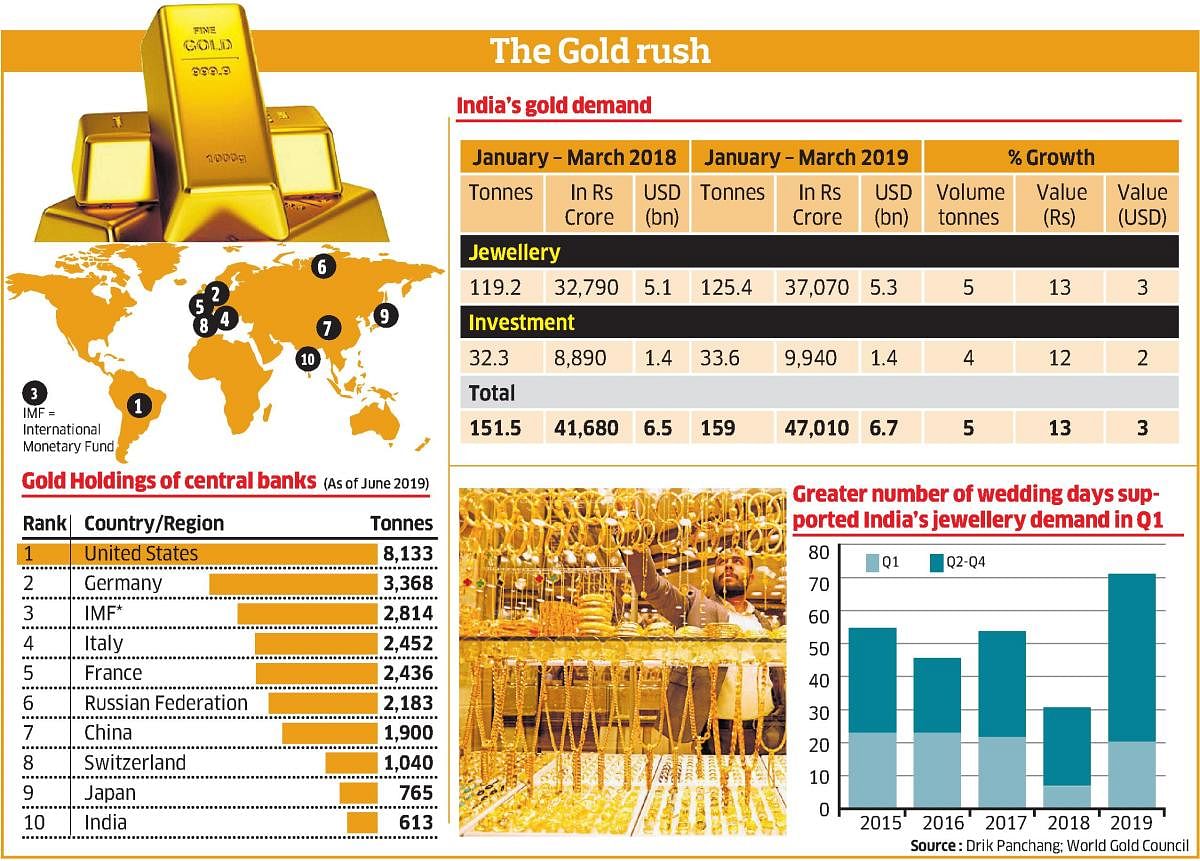Gold is on a winning streak, shining brighter than before. Investors, households, traders and central banks around the globe are parking cash in it. Gold has rallied its highest in the last six years in the international market. In India, it hit its highest ever on June 25. In one month, gold has gained 12% and it appears the bull run for the yellow metal will last longer than one thought.
The Reserve bank of India (RBI) alone bought over 52-tonne gold in last fiscal to shore up its reserves and now it is in the league of 10 top gold holding central banks on the globe. Not only RBI, the central banks of Russia, China and Turkey have added gold to their foreign exchange reserves in a big way.
But more of gold buying by individuals, nations or their central banks is not a good news. It indicates that the economy is not doing well, it is weakening and geopolitics is also uncertain. It also indicates that dollar, with which it shares an inverse relation, is not doing well. When the dollar, the world’s most powerful currency loses shine, gold takes over from there. In the month of June, it glittered the most, boosted on the back of a weakness in the dollar after the US Federal Reserve signalled it would cut interest rates, going forward, as the US economy was sagging.
Concerns arising out of mounting trade war and geopolitical tensions between the US and Iran have added to the dollar weakness and therefore lending an extra shine to gold. On June 25, gold hit its highest in six years, selling at Rs 35,800 per 10 grams, clawing back to 2013 level when it had touched the highest due to government’s desperate measure of an unprecedented import duty hike on the yellow metal. That came after the US taper tantrum or when US Federal Reserve Chairman Ben Bernanke hinted at the end of quantitative easing. That eventfully did not happen but it was a big negative sentiment.
Gold on MCX settled down -0.49% at Rs 34,387 on June 27 as US Federal Reserve officials played down expectations of aggressive rate cuts, while investors locked in profits following a strong rally. US Fed Chairman Jerome Powell asserted its central bank’s independence, stating that it is “insulated from short-term political pressures”, pushing back against President Donald Trump’s demand for a significant rate cut.
While this hosed down expectations for a half-percentage-point cut at the Federal Reserve’s July meeting, investors still expected at least a quarter percentage point reduction. Separately, St. Louis Federal Reserve President James Bullard said he did not think the US economy was dire enough to warrant a 50-basis-point cut in July. That helped prices from spiking further.
But the question is how the precious metal, the best hedge against inflation, is going to behave here-on? What will be its impact on the world’s second largest consumer and one of the largest importers, that is India?
India’s gold demand could fall 10% in 2019 from a year ago to the lowest level in three years as a rally in local prices to a record high dents retail purchases during a key festive season, according to Kedia Commodities.
India’s gold consumption eased 1.5% in 2018 to 760.4 tonnes, below a 10-year average of 838 tonnes, according to data compiled by the World Gold Council.
Gold prices could go above $1,500 an ounce this year unless the current situations such as rate cut noises by US Federal Reserve, US-China trade war, Iran tensions and central bank buying are sorted out. The sentiment in the precious market has turned extremely bullish, said Prithiviraj Kothari of Indian Bullion and Jewellers Association.
Price outlook
For the next year, the outlook on gold is that it could touch $1,600 an ounce in the international market and about Rs 40,000 to Rs 42,000 per 10 grams in the Indian market. And why the bullishness in gold will continue? The macroeconomic growth is falling the world over. Joblessness is not peculiar to India, jobs are falling across the globe and investors are not comfortable opening their purse strings due to the uncertain economic and political environment. Hence, the cash will be parked in the safest haven, the value of which could never come to zero.
The other reason for gold being on a tear is the risk of the ongoing trade war spiralling into a currency war. If that happens, gold will turn into a bigger monetary asset, it will gain further. The likelihood of more central banks joining in the race to buy gold will increase with the increase in anxiety about an uncertain future. Gold will also play as the most important asset class as global risks in equity markets rise.
But that can add to India’s macro-economic pain and the country’s rising current account deficit could go even worse. Right now the demand for gold has slumped in India as consumers have not seen such a price spike in many years. But it could again go up during the festive season.
Weak demand
Bullion dealers and jewellers said there was a drop in sales up to 60% below normal in June. Weak demand has been forcing dealers to offer a deep discount of up to 2% per 10 grams on the domestic prices. But this has a severe side effect. It could flare up back-channel gold imports into the country. A bullion dealer on the condition of anonymity said, no dealer could buy paying 3% GST and 10% customs duty and sell at 2% discount.
Currently, though, demand for gold had taken a hit in rural areas too. There are chances it could go up if the monsoon is good, giving the countryside folks a better purchasing power, who would also like to park their money in gold fearing a seasonal spike in inflation.
Besides, the industrial use of metal will remain at the current level. Gold is used by electronic companies for manufacturing of devices like television, computer, GPS. The industrial demand for gold accounts for 12% of the total demand for gold in the country. Gold is also used in making medicines, albeit in a small measure. Though it is estimated that India’s gold demand could fall to a three-year low in 2019, India would still remain the second biggest consumer after China. And that could be a potential problem for the government to deal with. More gold imports would mean more dollar outflow and a bigger pressure on CAD. Higher import duty would mean heightened smuggling and lower exports of gold jewellery. India needs a gold policy. The policy think-tank Niti Aayog has suggested that. A policy that focuses on promoting domestic gold industry and exports of gems and jewellery, which contribute about 15% to the total merchandise shipments from
India.

